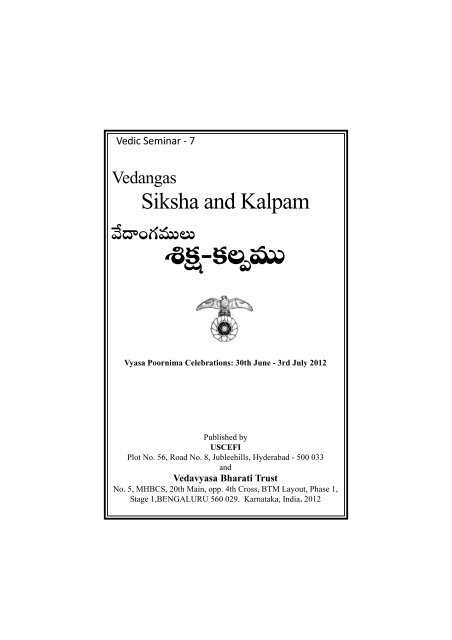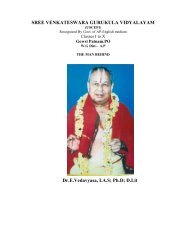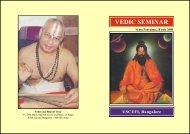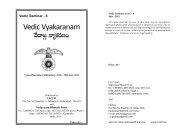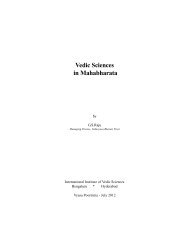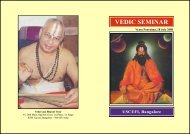Create successful ePaper yourself
Turn your PDF publications into a flip-book with our unique Google optimized e-Paper software.
Vedic Seminar - 7VedangasSiksha and Kalpam"Õ^•OQÆ=ÚÅ∞tHõΔ-HõÅÊ=ÚVyasa Poornima Celebrations: 30th June - 3rd July 2012Published byUSCEFIPlot No. 56, Road No. 8, Jubleehills, Hyderabad - 500 033andVedavyasa Bharati TrustNo. 5, MHBCS, 20th Main, opp. 4th Cross, BTM Layout, Phase 1,Stage 1,BENGALURU 560 029. Karnataka, India. 2012
Vedic Seminar series – 7July– 2012All rights reserved. No part of this book may be reproduced,duplicated, photocopied or utilized in any form or by any means electronicor mechanical, including recording, or by any Information storage andretrieval system, without prior permission in writing from the publishers.Price: 30 /-For Copies:Vedavyasa Bharati TrustNo. 5, MHBCS, 20th Main, opp. 4th Cross,BTM Layout, Phase 1, Stage 1,BENGALURU 560 029. Karnataka, India.AndUSCEFI,Plot No. 56, Road No. 8, Jublee Hills,Hyderabad 500 033, A.P. India.e-mail: vbt.iivs@gmail.comsr.gadiraju@gmail.comweb site: www.vedavyasabharati.<strong>org</strong>www.uscefi.<strong>org</strong>
q+¨Ü«∞ã¨∂zHõ1. HõÅÊã¨∂„`«=ÚÅ∞ - PQÆ=∞=ÚÅ∞ 52. tHͬ „áêuâßYºÅ qt+¨ì`« 153. "Õ^ŒVÍæx tHΔÍHõÖ∫Ê 264. â◊|Ì„|Ǩχ „Ѩuáê^Œ
HõÅÊã¨∂„`«=ÚÅ∞ - PQÆ=∞=ÚÅ∞ѨÓ[ºN _®. "Õ^Œ"åºã¨ QÆ∞~°∞^Õ=ÙÅ∞''K≥·`«#ºO âßâ◊fi`«O âßO`«O "Àº=∂f`«O x~°O[#O
~°zOK«|_ç#k HÍ=Ù# nxH˜ "≥·MÏ#㨠PQÆ=∞=∞x ¿Ñ~°∞ =zÛOk."Õ^Œ=ÚÅxflO\˜h =∞kèOK«_»O KÕ`« 'qY#㨗 â◊|ÌO U~°Ê_»∞`«∞O^Œx ÑÖ_ç`«∞Å∞K≥Ñ≤ÊÜ«Ú
J#QÍ ÉèíQÆ=O`«∞_»∞ K≥Ñ≤Ê# ÃÑ· â’¡HÍxH˜ J~°÷O 'D qY#㨠âß„ã¨ÎO`≥eã≤#"å~°∞, D âß„êÎxfl J#∞ãïOz J~Ú^Œ∞ =ӺǨappleÅ^•fi~å ##∞fl`≥Å∞ã¨∞H˘O@∞
„"å~ÚOKå#∞. nx=Å# âß„ã¨ÎO =e¡OK«@"Õ∞ H͉õΩO_®, ã¨q=∞~°≈QÍJ~°÷O KÕã¨∞HÀ=_®xH˜ gÅ∞ =ÙO@∞Ok. Z=Ô~·Ë "åºã¨∞Å "å~°∞ „|Ǩχã¨∂„`«O Ö’ "≥Ú^Œ@ K≥Ñ≤Ê#@∞ì ''J^è•`À„|Ǩχ l*Ï˝ã¨——. „|Ǩχ JO>Ë JO^ŒiH˜ `≥Å∞ã¨∞. Jk ÅѨ∞=ÙQÍ ãïáÈ^Œ∞.l*Ï˝ê`«‡HõOQÍ D „|Ǩχ JO>Ë Uq∞\˜? `≥Å∞ã¨∞HÀ"åe. KåÖÏ=∞Ok „|ǨχJO>Ë „|Ǩχ^Õ=Ù_»∞ Jx `ÕeHõQÍ fã¨∞H˘ËK«`«∞~°∞‡Y „|Ǩχ HÍ^Œ∞. PÜ«∞# "Õˆ~. „|Ǩχã¨∂„`åÅÖ’ K≥ѨÊ|_ç#Ѩ~°=∂`«∞‡_≥·# x~°∞æ} Ѩ~°„|Ǩχ "Õˆ~. JÖψQ ÉèíQÆ=næ`«Ö’ D „|Ǩχ J
L^Œ~Úã¨∞ÎOk. D „|Ǩχ, „|Ǩχã¨∂„`åÅÖ’ K≥ѨÊ|_ç# x~åHÍ~°∞_≥· qâ◊fi=∞O`å"åºÑ≤Oz LO_Õ „|Ǩχ XHõ>ËË W^ŒÌ~°∂ XHõ\˜ HÍ^Œ∞.HõÅÊOHõÖ’ÊHõÎ „ÑḦÍ~°O 'HõÅÊ—=∞#QÍ J~°úO : ''Kè«O^è£ó áê^Œó HõÅÊ Ç¨Ïã¨Îó `«^è•"åºHõ~°}Ï#
"Õ^Œ=∞O„`åÅ#∞ ~°Hõ~°HÍÅ „Ѩ„H˜Ü«∞ÅÖ’ LѨÜ≥∂yOK«∞HÀ=K«∞Û#∞. Uq^èŒOQÍJO>Ë Ñ¨Ó[‰õΩ, Jaè¿+HÍxH˜, HõàϺ}ÏxH˜ W`«~° JË =Ú#∞Å Ü≥ÚHõ¯ *Ï˝ÑḦÍxfl LѨÜ≥∂yOz q#flk, ^è•~°} KÕã≤K≥¿ÑÊk ã¨$‡u. ã¨~åãï ÉèíQÆ=#∞‡YO #∞O_ç =KÕÛk â◊$u. g\˜ÃÑ· P^è•~°Ñ¨_ç=Ù#fl "≥·kHõ Hõ~°‡Å∞ Ô~O_»∞ ~°HÍÅ∞. Jq „â∫`«, ê‡~°Î=ÚÅ∞. â◊$u „Ѩ^è•#"≥∞ÿ#Hõ~°‡Å∞ „â∫`«=ÚÅ∞. ã¨$‡u „Ѩ^è•#"≥∞ÿ# Hõ~°‡Å∞ ê‡~°Î=ÚÅ∞. Wq =∞ǨÏi¬„áÈHõÎ „Ѩ=∂}ÏÅ∞. ZO^Œ∞‰õO>Ë =∞ǨÏ~°∞¬ÖË ã¨$‡u Hõ~°ÎÅ∞ HÍ|\˜ì. PQÆ=∞=Úã¨$‡u. =∞ǨÏi¬ „áÈHõÎ „Ѩ=∂}Ï"≥∞ÿ#k. JO>Ë =∞ǨÏ~°∞¬Å∞ ‰õÄ_® Ѩ~°=∂`«‡
P^è•~°OQÍ K≥ѨC`å~°∞. HÍx ã¨~åãï "Õ^ŒOÖ’ ÉèÏQÆOQÍ =zÛ#@∞=O\˜kâ◊$u. =∞ǨÏ~°∞¬Å #∞Oz =zÛ#k ã¨$‡u. D ã¨$‡u Hõ~°ÎÅÖ’ =∞#∞=Ù, =∞#∞ã¨$‡uKÕâß~°∞. HÍ|\˜ì "åà◊§O^Œ~°∂ ã¨$‡u Hõ~°ÎÅ∞. JO^Œ∞Ö’ x`«º
K≥ѨÊ|_ç# Ѩ~°`«`åfixH˜ Ѩ~°"åã¨∞^Õ=ÙxH˜ q„QÆǨÏã¨fi~°∂áêxH˜ P^è•~°O. nxH˜„Ѩ=∂}OQÍ Ñ¨Ù~°∞+¨ã¨∂HõÎOÖ’ D =~°‚# KÕÜ«∞|_ç=Ù#flk. P ѨÙ~°∞+¨μ_çx=∞#O K«∂_»ÖË=Ú HÍ|\˜ì D ѨÙ~°∞+¨μ_çx =∞#O ã¨Ç¨Ï„㨠j~å¬Å`À PÅÜ«∞OÖ’ÃÑ@ìÖË=Ú. HÍ|\˜ì nxH˜ „Ѩ`åº=∂flºÜ«∞OQÍ, ÉèíQÆ=O`«∞_ç Ü≥ÚHõ¯ x~åHÍ~°"≥∞ÿ#â◊H˜Îx JO>Ë =∞# =∞#ã¨∞ûÖÏQÍ, HÍÅO ÖÏQÍ, h\˜ Pqi ÖÏQÍ, PHÍâ◊OÖÏQÍ, XHõ QÀK«~°O HÍ#@∞=O\˜ â◊H˜ÎH˜ q=∂#O ÃÑ·# HõÅâ◊O ÃÑ\ÏìO. JqP â◊H˜Îx PHõi¬êÎ~Ú. Jq fã¨∞H˘êÎ~Ú. JO^Œ∞HõË ^•xfl
''Pk`«º=∞OaHÍO q+¨μ‚O QÆ}
W=hfl Ü«∞[˝ ÑïHõ~åÅ#∞ Ñïâ◊√kÌ KÕÜ«∞@O HÀãÖ K≥Ñ≤Ê#q. D Ñïâ◊√kÌÉÏǨϺ Ñïâ◊√kÌ, =∞O„`« Ñïâ◊√kÌ, JO`«ó Ñïâ◊√kÌ Jx S^Œ∞ ~°HÍÅ∞QÍÑïâ◊√^Œ∞ÌÅ∞ K≥ѨÊ|_®¤~Ú. WO^Œ∞Ö’ QÆ$ǨϺã¨∂„`åÅ∞, „â∫`å ã¨∂„`åÅ∞,ê‡~°Îã¨∂„`åÅ∞, HõÅÊã¨∂„`åÅ∞, Ü≥∂QÆã¨∂„`åÅ∞, „|Ǩχã¨∂„`åÅ∂ L
tHͬ „áêuâßYºÅ qt+¨ì`«– ˆ~"≥∞à◊§ "ÕOHõ@~å=∞Hõ$+¨‚ âß„ã≤ÎÉèÏ~°`«^Õâ◊=Ú "Õ^ŒÉèí∂q∞. "Õ^Œ q*Ï˝# ÉèÏO_®QÍ~°=Ú. "Õ^ŒHÍÅ=ÚW^Œq∞`«÷=ÚQÆ K≥ѨÊ*ÏÅ=Ú. „ÑüHõÖÏÊk Ü«∞O^Œ∞#∞ „|Ǩχxâßfiã¨=Ú#∞O_ç"Õ^Œ=ÚÅ∞^ŒƒùqOK«∞K«∞#flq. "Õ^Œ=∞O„`«=ÚʼnõΩ „^Œ+¨ìÖËHÍx Hõ~°ÎÅ∞O_»~°∞.J
J=ã¨~°O. JO^Œ∞Ö’ ÉèÏQÆOQÍ "Õ^•OQÍÅ q*Ï˝#=¸ J=ã¨~°O. JO^Œ∞Ö’ÉèÏQÆOQÍ áê}˜hÜ«∞ tHõ¬#∞ QÆ∞iOz `≥eã¨∞‰õΩO^•O.tHͬâ◊|Ì =Ùº`«ÊuÎ:tHõ¬ q^Àºáê^•
D tHͬ„QÆO^ä•ÅÖ’ áê}˜hÜ«∞ tHõ¬ KåÅ „Ѩã≤^Œú"≥∞ÿ#k,ã¨=∞„QÆ"≥∞ÿ#k‰õÄ_®. ^•xÖ’ :-1. "åQÆ∞`«ÊuÎ „ѨHÍ~°=Ú 2. =~°‚=ÚÅ∞ 3. =~°‚ ÉË^Œ=ÚÅ∞4. ê÷#Hõ~°}q"ÕHõ=Ú(|Å=Ú) 5. áê~î°HõQÆ∞}=ÚÅ∞6. áê~î°Hõ^À+¨=ÚÅ∞ 7. =~À‚KåÛ~°} qkè (ê=∞º=Ú)8. LKåÛ~°}^ÀëêÅ∞ J
QÀK«~°OHÍ^Œ∞.=~°‚=ÚÅ∞ D q^èŒOQÍ ÖˇH˜¯OK«|_®¤~Ú -JK«∞ÛÅ∞ 21ã¨Ê~°≈=ÚÅ∞ 25Ü«∞ ~° Å = â◊ +¨ ã¨ Ç¨Ï 8Ü«∞=∞=ÚÅ∞ 4J#∞êfi~° qã¨~°æ=ÚÅ∞ 2lǨapplefi=¸bÜ≥∂Ѩ^蕇hÜ«∞=ÚÅ∞ 2^Œ∞óã¨Ê $+¨ì=Ú, Ѩ١`«Öϯ~°=Ú 2"≥Ú`«Î=Ú 64^Œ∞óã¨Ê $+¨ì=Ú#∞ =~å‚O`«~°=ÚQÆ ÖˇH˜¯OѨ‰õΩ#flKÀ 63. Ô~O_»K«∞ÛÅ=∞^茺#∞#fl Å HÍ~°=Ú#∞ ^Œ∞ã¨Ê $+¨ì=∞x JO\Ï~°∞.2. =~°‚=ÚÅ QÆ}#:„u+¨+≤ì â◊Û`«∞+¨¬+≤ì~åfi =~å‚ó â◊=Úƒù=∞`Õ =∞`åó„áêHõ$`Õ ã¨O㨯 $`Õ KåÑ≤ ã¨fiÜ«∞O „áÈHÍÎó ã¨fiÜ«∞OÉèí∞"åã¨fi~å qOâ◊u ˆ~Hõâ◊Û ã¨Ê~å≈
lǨapplefi=¸ÅO K« ^Œ
Å∞ `«∞ Š㨠Å∞ ^ŒO`«‡=ÚÅ∞. ‰õΩ lǨapplefi=¸Å=Ú. =HÍ~°=Ú ^ŒO`Àº+¨ªº=Ú.U S Å∞ HõO~î°`åÅ=º=ÚÅ∞. F B Å∞ HõO~î“+¨ªº=ÚÅ∞.5. áê~î°HõQÆ∞}=ÚÅ∞=∂^èŒ∞~°º=∞Hõ¬~°=ºH˜Îó Ѩ^ŒKÕÛù^Œã¨∞Î ã¨∞ã¨fi~°ó^è≥·~°ºO ÅÜ«∞ã¨=∞~°úO K« +¨_Õ`Õ áê~î°HÍ QÆ∞}Ïó (â’¡.33)=∂^èŒ∞~°º=Ú. JHõ¬~°=ºH˜Î, Ѩ^ŒKÕÛù^Œ=Ú, ã¨∞ã¨fi~°=Ú, ^è≥·~°º=Ú, `«y#ÅÜ«∞ Wq áê~î°HõQÆ∞}ÏÅ∞.6. áê~î°Hõ^À+¨=ÚÅ∞wf j„Ñ‘∞ t~°óHõg∞Ê `«^ä• ed`«áê~î°HõóJ#~°÷*’˝7 ÅÊHõ}ªâ◊Û +¨_Õ`Õ áê~î°HÍ^èŒ=∂ó (â’¡.32)êQÆnÜ«∞_»O,ã¨fi~°, `«Å∂Ѩ_»O, K«∂ã≤ K«^Œ=_»O, J~°÷*Ï˝#OÖËHõáÈ=_»O, Ç‘Ï#ã¨fi~°O`À K«^Œ=_»O Wq áê~î°Hõ^ÀëêÅ∞.7. =~À‚KåÛ~°} qkè"庄ё∞ Ü«∞^ä• Ç¨Ïˆ~`üѨل`å
=Ú‰õΩ¯`À, HÍH˜ÖÏ, =¸~°ú
~°zOz# |∞∞„HÍÊuâßYº „Ѩã≤^Œú"≥∞ÿ#k. â◊√Hõ¡Ü«∞Aˆ~fi^•xH˜ HÍ`åºÜ«∞#q~°z`«"≥∞ÿ# "å[ã¨
ã¨∂„fHõiOzOk. K«HÍ~åk Ѩ^ŒO Ѩ~°OQÍ L#flѨÙ_»∞ ѨÓ~°fiѨ^•Öˇ·#„`«Ñ¨Ù q∞^äŒ∞ Ѩ^•Å‰õΩ â◊HÍ~åQÆ=∞O =ã¨∞ÎO^Œx n#~°÷O.2. W^Õq^èŒOQÍ 'LÉèË ã¨∞â◊Û„#Ì ã¨iÊ+¨ ã¨∞=Û„#Ì ^Œã¨‡ qâ◊Ê`Õ— J
`≥eÜ«∞HõáÈ~Ú
K≥ѨÊ_»O=Å¡ '=#ã¨Î`Õ g_»fiOQÆ— J
"Õ^ŒVÍæx tHΔÍHõÖ∫Ê– ^À~°ƒùÅ „ѨÉèÏHõ~° â◊~°‡„Ñ≤xûáêÖò (i.), XiÜ«∞O@Öò ã¨O㨯 $`« HõàÏâßÅ,H˘=Ófi~°∞, ѨIIQÀ^•=i (l), PO„^茄Ѩ^ÕâòKè«#Ìóáê^ŒQÆ=∂ó x~°∞HõÎ q+¨Ü«∞„â’„`åaè~å=∞„tÜ«∞ótHΔ̈́Ѩ∂}ã¨∞œ~°ÉèÏó „Ѩqã¨~°`«¯ÖÏÊ„QÆǨÏÈÎ[˚fiÖÏó„âıÜ≥∂ "åºHõ~°}Ï#
`ÕuÎsÜ≥∂Ѩx+¨k tHΔÍÜ«∂ó ã¨fi~°∂Ѩ"Õ∞=O =i‚`«"£∞ -''jHΔÍO "åºMϺ êº=∞ó =~°‚ó, ã¨fi~°ó, =∂„`å, |ÅO, ê=∞ ã¨
㨇 $`«Ü«∞â◊Û. „â∫`«Hõ~å‡x „â◊√u„áÈHÍÎx ê‡~°ÎHõ~å‡}˜ 㨇 $u„áÈHÍÎx.Jyfl„`«Ü«∂^è•#O JyflǨϟ„`«"£∞ ^Œ~°≈ѨÓ~°‚=∂œ
K«O^èŒã¨∞û-áê^Œ=ÚÅ∞. x~°∞HõÎ=Ú-„â◊=}=Ú. "åºHõ~°}=Ú-=ÚY=Ú.*’ºu+¨=Ú-Hõ#∞fl. tHõΔ-=Ú‰õΩ¯, HõÅÊ=Ú-KÕ`«∞Å∞ - Jx Ö’Hõ „Ѩã≤kú.áê}˜}©Ü«∞ tHΔÍ„QÆO^èŒ=ÚÖ’ ‰õÄ_® Dq^èŒOQÍ
ê=∞=ÚÅ∞ - Wq +¨_£*Ï˚`«∞Å∞. =$+¨Éèí, QÍO^è•~°, =∞^茺=∞, ÑÖK«=∞^≥·=`«, xëê^Œ, ã¨O`å
Jyfl„`«Ü«∂^è•#O JyflǨϟ„`«"£∞ ^Œ~°≈ѨÓ~°‚=∂œ
â◊|Ì„|Ǩχ „Ѩuáê^Œ
=$kúx á⁄O^Œ∞K«∞
=∞i JÖÏO@ѨC_»∞ =~å‚ʼnõΩ ê^èŒ∞`«fiO „ѨuáêkOѨ|_»#O^Œ∞#"åºHõ~°}âߢã¨Î=∞O^Œ∞ JHõΔ~°ã¨=∂=∂flÜ«∂xfl ZO^Œ∞‰õΩ LѨ^ÕtOKåe? J#fl„Ѩâ◊fl‰õΩ =∞ǨappleÉèÏ+¨ºO kfifÜ«∂Ç≤ÏflHõOÖ’ Ѩ`«O[e =∞ǨÏi¬ Dq^èŒOQÍã¨=∂^è•#O K≥áêÊ~°∞.''=~°‚*Ï˝#O "åyfi+¨Ü≥∂ Ü«∞„`« K« „|Ǩχ =~°Î`ÕI`«^Œ~°÷q∞+¨ì|∞^Œúº~°÷O ÅѨ∞fi~°÷O KÀѨkâ◊º`ÕII——=~°‚*Ï˝#O ´ ''=~å‚ó *Ï˝Ü«∞
=∞ǨappleÉèÏ+¨ºO : ''ÈDÜ«∞=∞HõΔ~° ã¨=∂=∂flÜ«∞ó "åH± ã¨=∂=∂flÜ«∞óѨÙ+≤Ê`«ó Ѩe`«ó K«O„^Œ`å~°Hõ=`ü „Ѩu=∞O_ç`À "Õk`«"Àº „|Ǩχ~åtóIã¨~°fi"Õ^ŒÑ¨Ù}ºÑ¨ÖÏ"åÑ≤ÎâßÛ㨺 *Ï˝
D aO^Œ∞=ÙÖ’ z^ŒOâ◊=Ú, Jz^ŒOâ◊=Ú, z^Œz^ŒOâ◊=Ú J
"åHõºÑ¨nÜ«∞OP^ŒºO`«~°Ç≤Ï`«=¸, Jq
`«~°∞"å`« =¸~°ú^Õâ◊=Ú Ü≥ÚHõ¯ T~°úfi^Õâ◊=Ú#∞ KÕi JK«\˜#∞O_ç |Ü«∞@‰õΩ"≥_»Å∞@‰õΩ =∂~°æ=Ú ÖËHõ J^èÀ^Õâ◊=Ú =∞~°e, LKåÛ~°}Ï=Ü«∞==ÚÅQÆ∞`åÖÏfik ê÷#=ÚÅ#∞ KÕ~°∞`«∞Ok. PÜ«∂ê÷#=ÚÅO^Œ∞ P "åÜ«Ú=ÙKÕ`«Jaè=ºHõÎ=∞QÆ∞ "å‰õΩ¯ "≥·YiÜ«∞#|_»∞#∞. D "å‰õΩ¯ Ѩ~°„â’„`« „QÆǨÏ}Ü≥∂Qƺ=Ú. =∞^茺=∂ "å‰õΩ¯ =HõÎKÕ =∂„`«=Ú `≥Å∞ã¨∞HÀ^ŒQÆ∞#∞. "≥·Ys"å‰õΩ¯ JO^ŒiH© q#|_»∞#∞. "≥·Yi Ü«∞
ÉÏQÆ∞QÍ ã¨iÜ≥ÿ∞# suÖ’ =~°‚=ÚÅ#∞ LK«ÛiOz#"å_»∞ „|Ǩχ֒Hõ=∞O^Œ∞Q“~°qOѨ|_»∞#∞ Jx P HÍiHõ‰õΩ J~°÷=Ú. ''UHõó â◊|Ìó ã¨=∞ºQ∑ *Ï˝`«óã¨∞+¨μª „ѨܫÚHõÎó ã¨fiˆ~æ Ö’ˆH K« HÍ=∞^èŒ∞Qƃù=u—— Jx =∞ǨappleÉèÏ+¨ºOÖ’K≥ѨÊ|_≥#∞. "åºHõ~°} xÜ«∞=∂#∞ê~°=ÚQÍ, J~°÷*Ï˝# ѨÙ~°ã¨û~°=ÚQÍÉÏQÆ∞QÍ „ѨÜ≥∂yOѨ|_ç# â◊|Ì=Ú SÇ≤ÏHÍ=Ú+≤‡Hõ ѨÅ=ÚÅxK«∞Û#∞ JxP ÉèÏ+¨º=Ú#‰õΩ J~°÷=Ú.HÍ|\˜ì tHΔÍ"åºHõ~°}Ïk âߢã¨Î ã≤^•úO`«=Ú##∞ãïOz â◊|Ì"Õ∞ Ѩ~°„|Ǩχã¨fi~°∂Ѩ=∞x ã≤kúOz#k.T1. Name & : Prof. SRIPADA SUBRAHMANYAMAddress : DirectorAndhra Pradesh Government OrientalManuscripts Library and Research InstituteBehind O.U. Police Station, O.U.Campus,Hyderabad-500007Cell : 09848794939, Phone : 040-270977092. Qualifications: Vidyapraveena, M.A., Ph.D.3. Studied : Studied Nyaya, Vyakarana and Vedanta Sastrastraditionally under Guru BrahmaSri Goda Subrahmanya Sastry Garu, Kanchipuram.4. Awards : 1) Best Teacher award by Govt. of A.P.2) Advaita Siddhi Ratnakara3) Sastracharya.35
N "≥·MÏ#㨠HõÅÊã¨∂„`« "≥·t+¨ìº=ÚN "≥·MÏ#㨠q^•ºÉèí∂+¨}, PQÆ=∂Kå~°ºÑ¨O_ç`« "Õ^•O`«O QÀáêÅHõ$+¨ì=∂Kå~°∞ºÅ∞, #∂lg_»∞ÜÕ∞# "Õ^•~°ú q*Ë˝# Ö’HÍ#∞„QÆÇ¨Ï HÍ=∞ºÜ«∂„Ѩ}©`«O ã¨∂„`«O =∞øMËÜ«∞O `«Ãã·‡ qY#¿ã #=∞ó„tÜ«∞ó ѨuÜ«Ú J"åã¨Î ã¨=∞ã¨Î HÍ=Ú_»∞#∞ ã¨=∞ã¨Î HõÖϺ}QÆ∞}ÏHõ~°∂_»∞#∞#QÆ∞, N=∞
Éèí∞=~åk P~°∞Ö’Hõ=ÚÅO^Œ∞#∞ Hõ~å‡K«~°}=Ú ÖË^Œ∞. Éèí∂Ö’Hõ=∞O^Œ∞=∞Oz Hõ~°‡ÖÏK«iOz#"å~°∞ `«=∞ Hõ~°‡Ñ¨Å=Ú#∞ J#∞ÉèíqOK«∞@‰õΩ =∂„`«=ÚP Ö’Hõ=ÚÅ∞ L^ÕútOK«|_ç#q. JK«Û@ Hõ~å‡K«~°}=Ú#‰õΩ `«QÆ∞J=HÍâ◊=ÚÅ∞ ÖË=Ù. Hõ~°‡Éèí∂q∞Ü«∞QÆ∞ ÉèÏ~°`å=xÜ«∞O^Œ∞ [x‡OK«∞@ J
''HõÅʺ`ü ê=∞~°úº "åz
ã¨~åfiOQÆã¨∞O^Œ~°=∞x ѨÓ~°∞fiÖË
=¸Å#∞O_ç "≥∂KÕu z=~°=~°‰õΩ QÆÅ H˘Å`« - K«`«∞~°„ã¨=ÚQÍ`«Ü«∂~°∞KÕÜ«Ú áê„`«#∞ LMÏáê„`«Ü«∞O^Œ∞~°∞.LMÏáê„`« „ѨÜ≥∂QÆ=Ú#∞ QÆ∂iÛ „â∫`«=Ú#x@∞¡ K≥ѨÊ|_≥#∞.
7. =t+¨ìó - N=∞}ˆH
7. êOQÆ„H˜Ü«∂ HõÖÏѨ=`åfi`ü8. =∞
PQÆ=∞=ÚÅ∞ - HõÅÊã¨∂„`«=ÚÅ∞q=~°} : „|ǨχN J~°∞}‰õΩ=∂~ü Éèí@ì~°∞QÍ~°∞ÖˇHõÛ~°~ü, ã¨O㨯 $`« ã¨Oê÷
„=`«=ÚÅ∞ P~å^èŒ#Å∞.~Ú+¨ìHõ=ÚÅ∞ JO>Ë HÀiHõÅ`À KÕ¿ã ѨÓ*ÏkèHõ=ÚÅ∞ HÍ=∞ºHõ=ÚÅ∞J#QÍ Ñ¨e`åxfl PtOz Ѩل`«áœ„`åkè, ^èŒ
„QÆO^äŒ ã¨g∞HõΔ :N áê^Œ‡ ã¨OÇ≤Ï`«N áê^Œ‡ ã¨OÇ≤Ï`«Ö’ *Ï˝#áê^Œ=Ú, Ü≥∂QÆáê^Œ=Ú, „H˜Ü«∂áê^Œ=Ú=¸_»∞ HõeÊ „Ѩ^èŒ=∞ ã¨OѨÙ@=ÚQÍ "≥∞ÿã¨∂~°∞#QÆ~°=Ú#O^Œ∞#fl „áêp#ã¨O㨯 $`« „QÆO^äŒ „ѨHõ@# qâ◊fi ã¨Oã¨÷ (International Academy of SanskritResearch ) "å~°∞ „ѨK«∞iOzi. D „QÆO^èŒ=Ú#∞ N=∂
Ѩ~°=∞ѨÙ~°∞+¨ ^Œ~°≈#=Ú, ã¨$+≤ì ã≤÷u ãÖǨapple~° q+¨Ü«∞=ÚÅ∞, |O^èŒ "≥∂HõΔ=ÚÅ∞"å\˜ q=~°}, "åã¨∞^Õ= =¸iÎ =ÚHõÎ ã¨fi~°∂Ѩ=Ú, ã¨Oê~°=Ú# =ÙO_Õ|O^èŒ# - JO^Œ∞O_ç "≥∂HõΔ=Ú, =ÚHÍÎ`«‡Å∞, Ѩ~°=∞ѨÙ~°∞+¨μ_≥·# "åxxKÕ~°∞ "≥∂HõΔ x~°∂Ѩ}=Ú. „ѨHõ$u ѨÙ~°∞+¨μÅ ã¨OÜ≥∂QÆ=Ú, ã¨~°fi „H˜Ü«∂`«‡Hõ*Ï˝#=ÚÅ∞ W=fi|_ç#q.áêOK«~å„`« qkè áêOK«~å„`« nHõΔ nxH˜ ã¨OÉOkèOz# =ã¨∞Îã¨fi~°∂Ѩ=ÚÅ∞, „ÑḦõ$u qHõ$u x~°∂Ѩ}=Ú, „ÑḦõ$u Ü≥ÚHõ¯ „Ñü~°∂Ѩ=ÚQÍL^ŒƒùqOKÕ [QÆ`«∞Î ã¨$ëêìºkè q+¨Ü«∞=ÚÅ∞ Ѩ~°=∂`«∞‡_≥·#
„H˜Ü«∂ ÉèÏQÆ=ÚPKå~°º ÅHõΔ}=ÚÅ∞, ÉèíQÆ=#∂‡iÎ Ü≥ÚHõ¯ Ü«∞[#=Ú, ѨÓ*Ïê÷#qâı+¨=Ú, Éèí∂ ѨsHõΔ, Éèí∂ "åã¨∞Î HõÅÊ#, |e „Ѩ^•#O "≥Ú^ŒÖˇ·# „Ѩ„H˜Ü«∞Å∞x~°fiÇ≤ÏOK«∞@, „ÉÏǨapple‡}Ïk =~°‚=ÚÅ "åi, "å# „Ѩã¨÷#=Ú# =Ù#fl "åixã¨=∂Yº Ѩ~°z x~°fiÇ≤ÏOK«=Åã≤# q^èŒ∞Å∞, ÉèÏ㨯~åkè ^Õ=`« ê÷# ^•fi~åx~°∂Ѩ}=Ú, "åi J~°Û
q+¨Ü«∂Å∞ q=~°OQÍ ~Ú=fi|_ç#q.=∞~˘Hõ J^蕺ܫ∞=Ú# =¸Å =~°∞Å∞ "åi „Ѩ=∂}=Ú, tÖÏÅHõΔ}=ÚÅ∞, L`«Î=Ú tʼnõΩ QÆ∞}=ÚÅ∞ JO`ÕH͉õΩO_® ‰õÄ~°∞Ûx =Ù#fl=¸Å=~°∞Å „Ѩ=∂#=Ú(Pã‘# =¸iÎ =∂#O) JÖψQ Ѩ^Œ‡
N"≥·MÏ#㨠HõÅÊã¨∂„`«=ÚÅ∞N=∂
Ѩ~°ºO`«=Ú q~ålÅ∞¡`«∂ HõeÜ«ÚQÆ k=ºˆHΔ„`«OQÍ D Éèí∂=∞O_»ÖÏxˆH=∞‰õΩ\ÏÜ«∞=∂#OQÍ q~ålÅ∞¡K«∞#fl u~°∞=∞Å N"ÕOHõ>Ëâ◊fi~°∞x k=ºã¨xfl^è•#=ÚÖ’ ‰õÄ_® JqzÛ#fl =Oâ◊Ѩ~°OѨ~åQÆ`«OQÍ J~°Û#–L`«û=–ã¨flѨ#–„áêÜ«∞tÛ`«Î– qâı+¨ ѨÓ*Ï^Œ∞Å`À PK«iOѨ|_»∞`«∞Ok."≥·kHõ=∂~°æ=Ú# „Ѩã≤kÌK≥Ok# N"≥·MÏ#ã¨ÉèíQÆ=KåÛù„ã¨Î=Ú#‰õΩP^è•~°„QÆO^äŒ=Ú P^Œº„QÆO^äŒ=Ú „áê=∂}˜Hõ=Ú N"≥·MÏ#ã¨HõÅÊã¨∂„`«=Ú.D ã¨∂„`«=Ú#O^Œ∞ 32 „Ѩâ◊flÅ∞ QÆÅ=Ù. JO^Œ∞QÆ$ǨϺã¨∂„`«=Ú 7 „Ѩâ◊flÅ∞QÆ#∂,^èŒ~°‡ ã¨∂„`«=Ú 3 „Ѩâ◊flÅ∞QÆ#∂,„Ѩ=~° ã¨∂„`«=Ú 1 „Ѩâ◊flQÆ#∂,„â∫`«ã¨∂„`«=Ú 21 „Ѩâ◊flÅ∞QÆ#∂ qÉèílOѨ|_ç#q. gxÖ’QÆ$ǨϺã¨∂„`«=Ú #O^Œ∞x¿+Hõ–|∞∞`«∞ã¨OQÆ=∞#–QÆ~åƒù^è•#–ѨÙOã¨=#–ã‘=∞#Ζq+¨μ‚|e"≥Ú^ŒÅQÆ∞ 18 ã¨Oê¯~°=ÚÅ∞, ѨOK«=∞ǨappleÜ«∞[˝=ÚÅ∞ áêHõÜ«∞[˝=ÚÅ∞"å\˜ „áêÜ«∞tÛ`«Î q^è•#=ÚÅ∞, HÍÅ=ÚÅ∞ – J#∞ëêì# q^è•#=ÚÅ∞LѨ^ÕtOѨ|_ç#q.WOHÍ WO^Œ∞ PѨ¸~°q^è•#=Ú, QÆ$Ǩapple~åÛaO|„Ѩu+¨ì, q+¨‚fi~°Û
qâßfiq∞„`« – =t+¨ì – [=∞^Œyfl "≥Ú^ŒÅQÆ∞ Zxq∞k =∞Ok =∞ǨÏ~°∞¬ÅÜ≥ÚHõ¯ QÀ„`«„Ѩ=~°Å∞ x~°∂Ñ≤OK«|_ç#q.„â∫`«ã¨∂„`«=Ú#O^Œ∞ǨÏq~°fi[˝ – È=∞Ü«∞[˝=ÚÅ PK«~°}q^è•#=Ú, HÍÅ=Ú, "å\˜Ñ¨e`«=ÚÅ∞, Ü«∂QƉõΩO_®k x~å‡}=ÚÅ∞ êOQÀáêOQÆ=ÚQÆK«iÛOK«|_ç#q.N=∞^≥·fiMÏ#ãḦõÅÊã¨∂„`«=Ú Ü≥ÚHõ¯ qt+¨ì`«#∞ q=iOK«∞K«∂ "Õ^•#Î^Õt‰õΩÅ∞ (Nx"åã¨=∞d) ^Œâ◊q^茿ÇÏ`«∞=ÙÅ`À Wk Ѩ~°=∞ L`«$¯+¨ì`«#∞á⁄Ok# q^è•#=Ú#∞, Ѩ~°=∞"≥·+¨ì=`«fi=Ú êkèOz# f~°∞, â◊$u=∂~°æ=Ú#∞J=ÅOaèOz# q^è•#=Ú x~°∂Ñ≤OzÜ«Ú
áêOK«~å„`åQÆ=∞=ÚѨÓ[ºN _®. "Õ^Œ"åºã¨ QÆ∞~°∞^Õ=ÙÅ∞PQÆ=∞âß„ã¨Î=Ú ^Õ"åÅÜ«∞ x~å‡}=Ú ÉèíQÆ=O`«∞_ç q„QÆǨapplexH˜LO_»=Åã≤# ê=Ú„kHõ â◊√ÉèíÅHõΔ}=ÚÅ∞ QÆ∞_çÖ’ KÕÜ«∞=Åã≤# ѨÓ*Ïq^è•#O PÅÜ«∞„Ѩuëêª HõÅÊ=Ú, ^Õ"åÅÜ«∞ x~å‡}=Ú, ^èŒfi[ã¨÷OÉèí=Ú,=ÚY=∞O_»Ñ¨O QÀѨÙ~°O, QÆ~°ƒùÅÜ«∞O JO`«~åà◊O =O\˜q, =ÙO_®eû#PHÍ~°=Ú H˘Å`«Å∞ – "≥Ú^ŒÖˇ·# âß„ã¨Îq+¨Ü«∂Å∞ J
â◊H˜Îx ÖË^• – D =¸_çO\˜h ã¨OѨÙ\˜KÕã≤ =∞Ǩapple„uѨÙ~°ã¨∞O^ŒiQÍ#∂~å[~å*Ëâ◊fiiQÍ#∂ P~åkèOK«|_»∞`«∞#flk.WHõáÈ`Õ "≥·+¨‚"åQÆ=∂Å∞ „Ѩ^è•#OQÍ Ô~O_»∞~°HÍÅ∞! (1)"≥·MÏ#êQÆ=∞O, (2) áêOK«~å„`åQÆ=∞O! "≥·MÏ#êQÆ=∞O qY#ã¨|∞∞+≤„áÈHõÎ"≥∞ÿ# PQÆ=∞O Hõ#∞Hõ "≥·MÏ#ã¨=∞x ¿Ñ~°∞ Hõey#k! WHõáÈ`ÕáêOK«~å„`åQÆ=∞O QÆ∞iOz WHõ¯_» q=~°OQÍ `≥Å∞ã¨∞‰õΩO^•O!áêOK«~å„`åQÆ=∞O:N=∞^•ƒùQÆ=`«OÖ’ N=∞Ǩappleq+¨μ‚=Ù „Ѩ^è•#^Õ=`«QÍ K≥ѨÊ|_ç
J#QÍ WǨÏÖ’Hõã¨O|O^èŒ"≥∞ÿ# q+¨Ü«∞=ÚÅ∂, (5) J~°Û# J#QÍq„QÆǨapple~å^èŒ# ~°∂ѨOÖ’ Ѩ~°=∂`«∞‡_çx P~åkèOKÕ q^è•#=¸.''=ӺǨÏO—— J#QÍ ÉèíQÆ=O`«∞_»∞ qâ◊fiOÖ’
2) Jx~°∞^Œú ã¨OÇ≤Ï`« (34–J^蕺ܫ∂Å∞) :– nx
„Hõ=∞O, Ü≥∂QÍÉèϺã¨=Ú, =∞O„`ÀѨ^Õâ◊=Ú, =∞O„`«Ñ¨Ù~°Û~°},=∞O„`«ã≤kÌ, qq^èŒ q+¨μ‚ =∞O„`«=ÚÅ∞, q+¨μ‚ J~°Û
- â◊s~°OÖ’
JO`«~åºq∞Ü«∞QÆ∞ r=ѨÙ~°∞+¨μ_»∞, |Ç≤Ï~åºq∞Ü«∞QÆ∞ qâ◊fiѨÙ~°∞+¨μ_»∂†ã¨∂÷Åã¨$+≤ìÖ’ ÉèÏQÆ=ÚÅ∂, „ѨHõ$u ѨÙ~°∞+¨μÅ QÆ∞iOz =i‚Oã¨∞ÎOk.WO^Œ∞Ö’x q+¨Ü«∂Å∞ ÉèíQÆ=næ`«Ö’ K≥Ñ≤Ê# 1) HõΔ~° ѨÙ~°∞+¨μ_»∞2)JHõΔ~° ѨÙ~°∞+¨μ_»∞ 3) ‰õÄ@ã¨÷ѨÙ~°∞+¨μ_»∞, 4) ѨÙ~°∞ëÈ`«Î=Ú_»∞QÆ∞iOz# q=~°}#∞ áÈe=ÙO@∞Ok!16. q+¨μ‚`«`«Îfi ã¨OÇ≤Ï`« :- 39-J^蕺ܫ∂Å∞ Hõey# D êOK«~å„`«„QÆO^äŒOÖ’ Jaè¿+Hõq^è•#O, =∞O„`«nHõΔ-=∞O„`«êfl#O,J=Éèí$^èŒêfl#O, â◊s~°=ÚÖ’ - #∞^Œ∞\Ï Kèåfg∞^Œ ǨÏ$^ŒÜ«∞=Ú#O^Œ∞^èŒiOK«=Åã≤# "≥·+¨‚=
=ÚO^Œ∞QÍ „Ѩ^è•#=Ú L^Œƒùqã¨∞ÎOk! Ô~O_»= ^Œâ◊Ö’ ~°*’QÆ∞}=ڄѨHÀã≤Oz JǨÏOHÍ~°O U~°Ê_»∞`«∞Ok! =¸_»=^Œâ◊Ö’ ã¨`«ÎfiQÆ∞}OÖ’ |∞kúU~°Ê_»∞`«∞Ok! P`«‡ÖÖ’ =¸_»∞(3) ~°Hõ=ÚÅ∞ K≥ѨÊ|_ç
tã¨∞ºÅH˜KÕÛ =∞O„`«nHõΔ† `«^•fi~å P`«‡, =∞#ã¨∞û â◊s~°O Ñïâ◊√^èŒú"≥∞ÿ =∞#ã¨∞ûx~°‡Å"≥∞ÿ HÍ=∞„HÀ^è•Å∞ ÖˉõΩO_® PHÍâ◊O=ÖË ÉèíQÆ=O`«∞xÃÑ· UHÍ„QÆ`«Ö’xez PÜ«∞# Ü«∞O^Œ∞ Ѩ~°=∞ „¿Ñ=∞ J#|_Õ ÉèíH˜Î^•fi~å ÉèíQÆ"å#∞xÖ’b#O HÍ=_»"Õ∞ "≥∂HõΔO!ÉèíQÆ=O`«∞x Láêã≤OKÕ D =∂~°æOÖ’ áêOK«~å„`«OÖ’ Ô~O_»∞ ^Œâ◊Å∞K≥ѨÊ|_ç
(5) "åã¨∞^Õ=Ù_»∞ Jx =i‚ã¨∞ÎOk áêOK«~å„`«O!"åã¨∞^Õ=Ù_»#QÍ ã¨~°fir=ÙÅ P`«‡ÅÖ’#∂ â◊s~åÅÖ’#∂ – x"åã¨O=ÙO_Õ"å_»x J~°÷O! ÉèíQÆ=O`«∞_»#QÍ 'ÉèíQÆO— J#QÍ `Õ[ã¨∞û! =O`«∞_»#QÍã¨∂~°∞ºxHõO>Ë HÀ@¡Ô~@∞¡ `Õ[ã¨∞û`À "≥eˆQ"å_»x J~°÷O! WÖÏQÆ ÉèíQÆ=O`«∞_»
=i‚Oz#O^Œ∞# "å\˜x =∞m§ WHõ¯_» uiy ѨÙ#~°∞H˜Î KÕÜ«∞#=ã¨~°O ÖË^Œ∞!Wk – ã¨O„QÆǨÏOQÍ áêOK«~å„`åQÆ=∞O ã¨fi~°∂ѨO! WO^Œ∞Ö’ KåÖÏ„QÆO^ä•Å∞ „Ѩã¨∞Î`«O ÅaèOK«_»O Hõ+¨ìO! H˘xfl „áêp# `åà◊Ѩ„`åÅÖ’ =Ù
"Õ^•^茺ܫ∞#OÖ’J+¨ìqHõ$`«∞Å∞"Õ^Œ q^•fi
„Hõ=∞ =∂ÖÏ :„Éèí∂Ü«∂`ü „Hõ=∞ qѨ~åºê =~°úêºk`ÀO`«ó (k`«ó{JO`«`«ó)JO`«O KåkO #O"Õ∞ ^ÕqO „Hõ=∞=∂ÖËu wÜ«∞`ÕID "Õ^ÀKåÛù~°}Ï q^è•#O qѨs`«„Hõ=∞O J#QÍ reverse „Hõ=∞Onxx „Hõ=∞ =∂ÖÏ Jx `≥eÜ«∞=Öˇ#∞.„Hõ=∞=∂ÖÏ LKåÛù~°}Ï „Hõ=∞O 1 2 6 6 2 3 6 56 J
5. ^èŒfi*Ï: Wk S^Œ= qHõ$u„|∂Ü«∂`ü P^èÕ`ü „Hõ=∞O ã¨=∞ºH± JO`å ^Œ∞`åÎ~°ÜÕ∞^Œºu=ˆ~æK« ~°∞z"åÜ«∞`åfi Ѩ~î°#O 㨠^èŒfi[O ã¨$‡`«ó„Hõ=∞OÖÏQÆ PYi Ѩ^ŒO uiy "≥#Hõ Ѩ^ŒO LK«ÛùiOK«@O, XHõêiP=~ÀǨÏ} =∞~ÀHõêi P~ÀǨÏ}6.^ŒO_»: Wk P~°= qHõ$u„Hõ=∞=ÚHÍÎfiqѨ~°ºã¨º ѨÙ#â◊Û„Hõ=∞=Ú`«Î~°OJ~°÷~åâßÛ ^Õ= =ÚHÀÎÜ«∞O „Hõ=∞^ŒO_À JaènÜ«∞`Õ.7. ~°^ä•: Wk U_»= qHõ$uáê^ŒÜ«∞ó J~°Ì~°^èŒ~°â◊Û ÈÉèÏÑ≤ ã¨Ç¨ÏŸHÍκ ^ŒO_»=„^èŒ^äŒóWq =¸_»∞ q^èŒ=ÚÅ∞ : kfiK«„Hõ ~°^䌌, „uK«„Hõ, K«`«∞â◊Û„Hõ ~°^èŒkfiK«„Hõ ~°^äŒ qHõ$u, 1/ 2 J#QÍ ÉèÏQÆO |∞∞H± (ѨÓ~åfi~°ú, L`«Î~å~°÷)WO^Œ∞Ö’ Ô~O_»∞ ^ŒO_® qHõ$uÅ∞#flq. LK«Û~°}‰õΩ D Ô~O_»∂#∂fã¨∞H˘#|_»`å~Ú.=∞O„`«^ŒfiÜ«∞㨺 ã¨Ç¨ÏŸHõÎÑ≤ kfiK«„HÀ ~°^äŒ`À"åºÑ≤ã¨Ç¨ÏŸH˜Îáê~î° ÉèË ^Õ# êfikfi^• qÉèí[º`ÕD Ô~O_»∞ =∞O„`«=ÚÅ#∞ W^ŒÌ~°∞ LK«ÛiOK«=K«∞Û#∞. nx `«~åfi`«„uK«„Hõ~°^äŒ =Ù#flk. (nxH˜ â’¡HõO W=fi|_»ÖË^Œ∞ XHõ "åHõºO =∂„`«OK≥ѨÊ|_ç#k.)ѨÓ~ÀfiHõÎÜ≥∂ó ^ŒfiÜ≥∂=∞O„`« Ü≥∂ó ã¨Ç¨ÏŸHÍκ kfiK«„HÀ Éèí=uWk kfiK«„Hõ H˜ =iÎã¨∞ÎOk.„uѨ^• QÍÜ«∞„f =∞O„`«ã¨º ã¨=∂# Ѩ^Œ ã¨OMϺ`åÎfi`üã¨=∂# Ѩ~° „uK«„HÀ~°^äÀ Éèí=u.ã¨=∂#"≥∞ÿ# ã¨OYº Hõey# áê^Œ=ÚÅ∞ QÍx WO^Œ∞Ö’ =ÙO_»∞#∞.K«`«∞â◊Û„Hõ ~°^äŒ: D qHõ$uÖ’ ‰õÄ_®
8. Ѩ∞
ÑÖK«ãÖkè: ÅHõΔ}"£∞J#∞t„`«¯=∞â’Û„`«¯=∞â◊Û =Ùº„`«¯"≥∂ Jaè„Hõ=∞ã¨Î^ä•ã¨O„Hõ=∞âıÛu ѨOK«~Ú`Õ [\ÏÜ«∂OHõkè`åó „Hõ=∞óWk ѨOK« ã¨Okè q=~°}. D „Hõ=∞=ÚÅ∞ ã¨OÇ≤Ï`å=∞O„`«=ÚʼnõΩ J#fi~ÚOK«∞#∞. „Hõ=∞ q^è•
"Õ^•OQÆ hu :"Õ^•OQÆ=ÚÅ∞ K«^Œ∞=Ù‰õΩ#fl Hõ~°∞‚_»∞=∞ǨappleÉèÏ~°`«O PkѨ~°fiOÖ’ N "Õ^Œ"åºã¨ =∞ǨÏi¬ áêO_»=ÙÅ∞‰õΩOuѨل`«∞_≥·# ‰õ~°∞‚_»∞
É’kèOK«=K«∞Û#∞ Jx `≥eÜ«∞K«∞#flk. D Ѩ^ŒÌu J#∞ã¨iOK«_»O=Å#"Õ^•OQÆ=ÚÅ∞ „ѨKå~°OÖ’H˜ =zÛ `«^•fi~å "Õ^Œ=ÚÅÃÑ· ÉèíH˜Î „ѨѨ`«∞ÎÅ∞Q“~°==Ú ÃÑ~°QÆQÆÅ=Ù. D "Õ^•OQÆ=ÚÅ J^茺ܫ∞#O =Å# =∞Ozã¨Oê¯~°=ÚÅ∞ HõÅ∞QÆQÆÅ=Ù- ã¨O.69
Shiksha and Kalpa- A Brief Introduction- Ed.1 . ShikshaShiksha is one of the six Vedangas, treating the traditional Hinduscience of phonetics and phonology of Sanskrit. Its aim is theteaching of the correct pronunciation of the Vedic hymns andmantras. The oldest phonetic textbooks are the Pratishakyas(pratisakhya, a vrddhi abstract from Sanskrit prati-sakha), describingpronunciation, intonation of Sanskrit, as well as the Sanskrit rulesof sandhi (word combination), specific to individual schools orShakhas of the Vedas.PratishakhyasThe Pratishakhyas, which evolved from the more ancient Vedic Textspadapathas, deal with the manner in which the Vedas are to beenunciated. There are separate Pratishakhyas for each Veda. Theyare a complement to the books called Shiksha written by variousauthorities.Five Pratishakhyas are preserved:a. Rigveda-Pratishakya (Shakala shakha), attributed toShaunakab. Shukla Yajurveda-Pratishakhyac. Taittiriya (Black Yajurveda) Pratishakhyad. Atharvaveda-Pratishakhya (Shaunakiya shakha)70
e. Shaunakiya Chaturaadhyaayika (Shaunakiya shakha)The Shiksha Texts and the Pratishakhyas led to a great clarity inunderstanding the surface structure of language. For clarity ofpronunciation, they propose breaking up the large Vedic compoundsinto stems, prefixes, and suffixes. Certain styles of recitation (patha)such as the jatapatha involved switching syllables, repeating the lastword of a line at the beginning of the next, and other permutations.In the process, a considerable amount of morphology is discussed,particularly regarding the combination of sequential sounds, whichleads to the modalities of sandhi.Other Shiksha textsIn addition, several Shiksha texts exist, most of them in metricalverse form but a few in sutra form. Some of these surviving textsare:1. Amoghanandini Shiksha2. Apisali Shiksha (in sutra form)3. Aranya Shiksha4. Atreya Shiksha5. Avasananirnyaya Shiksha6. Bharadvaja Shiksha7. Chandra Shiksha of Chandragomin (sutra form)8. Charayaniya Shiksha9. Galadrka Shiksha10. Kalanirnya Shiksha71
11. Katyayani Shiksha12. Shiksha13. Kaundinya Shiksha14. Keshavi Shiksha15. Kramakarika Shiksha16. Kramasandhaana Shiksha17. Laghumoghanandini Shiksha18. Lakshmikanta Shiksha19. Lomashi Shiksha20. Madhyandina Shiksha21. Mandavya Shiksha22. Mallasharmakrta Shiksha23. Manasvaara Shiksha24. Manduki Shiksha25. Naradiya Shiksha26. Paniniya Shiksha (versified)27. Paniniya Shiksha (in sutra form)28. Paniniya Shiksha (with accents)29. Parashari Shiksha30. Padyaatmika Keshavi Shiksha72
31. Pari Shiksha32. Pratishakhyapradipa Shiksha33. Sarvasammata Shiksha34. Shaishiriya Shiksha35. Shamaana Shiksha36. Shambhu Shiksha37. Shodashashloki Shiksha38. Shikshasamgraha39. Siddhanta Shiksha40. Svaraankusha Shiksha41. Svarashtaka Shiksha42. Svaravyanjana Shiksha43. Vasishtha Shiksha44. Varnaratnapradipa Shiksha45. Vyaali Shiksha46. Vyasa Shiksha47. Yajnavalkya ShikshaAlthough many of these Shiksha texts an attached to specific Vedicschools, others are late texts.73
Each vowel can be classified into three types based on the time ofpronunciation (morae). The unit of time is matra (approx. 0.4 second).They are,1. Hrasva : Short vowel, Eka-matra2. Dirgha : Long vowel, Dvi-matra3. Pluta : Prolonged vowel, Tri-matra (pluti)Each vowel can be classified into two types based on the manner ofpronunciation. They are1. Mukha : Oral2. Nasika : Nasal (all vowels are considered phonemically oral)Each vowel can be classified into three types based on accent ofarticulation. This was lost in Classical Sanskrit, but used in recitingVedic & Upanishadic hymns and mantras1. Udatta : high pitch2. Anudatta : low pitch3. Svarita : falling pitch2. Kalpa[Reference: http://en.wikipedia.<strong>org</strong>/wiki/Shiksha]Kalpa is one of the six disciplines of Vedanga, treating ritual. TheKalpa-sutras, or rules of ceremonial, are of two kinds:1. the Srauta-sutras, which are based on the shruti, and teachthe performance of the great sacrifices, requiring three orfive sacrificial fires; and74
2. the Smarta-sutras, or rules based on the smrti or tradition.The latter class again includes two kinds of treatises:a. the Grhyasutras, or domestic rules, treating the ritesof passage, such as marriage, birth, namegiving, etc.,connected with simple offerings into the domestic fire;andb. the Dharmasutras, which treat customs and socialduties, and have formed the chief sources of the laterlaw-books.Further, the Srauta-sutras of the Yajurveda have usually include aset of so-called Shulva-sutras, i.e. rules of the cord, which treat ofthe measurement by means of cords, and the construction, of differentkinds of altars required for sacrifices. These treatises are of specialinterest as supplying important information regarding the earliestgeometrical operations in India. Along with the Sutras may be classeda large number of supplementary treatises, usually called Parisista,on various subjects connected with the sacred texts and Vedic religiongenerally.Srauta SutrasThe Srautasutras (srautasutra) form a part of the corpus of SanskritSutra literature. Their topic is the instructions relating to the use ofthe shruti corpus in ritual (‘kalpa’) and the correct performance ofrituals as such. Some early Shrautasutras were composed in the lateBrahmana period (such as the Baudhyanana and Vadhula Sutras),but the bulk of the Shrautasutras are roughly contemporary to theGrhya corpus of domestic Sutras, their language being late VedicSanskrit, dating to the middle of the first millennium BCE, generallypredating Panini).75
VedaRigvedaSâmavedaKrishna YajurvedaSukla YajurvedaAtharvavedaSrautasûtraAsvalayana SrautasutraSankhayana SrautasutraLâtyâyana SrautasûtraDrâhyâyana SrautasûtraJaiminiya SrautasûtraBaudhâyana SrautasûtraVâdhûla SrautasûtraMânava SrautasûtraBharadvâja SrautasûtraÂpastamba SrautasûtraHiraEyakeœi SrautasûtraVârâha SrautasûtraVaikhânasa SrautasûtraKâtyâyana SrautasûtraVaitâna SrautasûtraGrhya SutrasThe Grhya Sutras “domestic sutras” are a category of Sanskrit textsprescribing Vedic ritual, mainly relating to rites of passage. Theirlanguage is late Vedic Sanskrit, and they date to around roughly 500BCE, contemporary with the Shrautasutras. They are named afterVedic shakhas.76
VedaRigvedaÂsvalâyana-GrhyasûtraKausîtaki-GrhyasûtraSkhâyana-GrhyasûtraGrhyasûtraSâmavedaGobhila-GrhyasûtraKhâdira-Grhyasûtra (Drâhyâyana-Grhyasûtra)Jaiminiya-GrhyasûtraKauthuma-GrhyasûtraKrisna Yajurveda Baudhâyana-GrhyasûtraHirayakeúi-Grhyasûtra(Satyâsâdha-Grhyasûtra)Mânava-GrhyasûtraBhâradvâja-GrhyasûtraÂpastamba-GrhyasûtraÂgniveœya-GrhyasûtraVaikhânasa-GrhyasûtraKâthaka-Grhyasûtra (Laugâksi-Grhyasûtra)Vârâha-GrhyasûtraVâdhûla-GrhyasûtraKapisthala-Katha Grhyasûtra (unpublished)Sukla YajurvedaPâraskara-GrhyasûtraKatyayana-GrhyasûtraAtharvavedaKauœika GrhyasûtraDharma SutrasThe Dharma sutras are Sanskrit texts dealing with custom, ritualsand law. They include the four surviving written works of the ancient77
Indian tradition on the subject of dharma, or the rules of behaviorrecognized by a community. Unlike the later Dharmashastra, thedharmasutras are composed in prose. The oldest Dharmasutra isgenerally believed to have been that of Apastamba, followed by thedharmasutras of Gautama, Baudhayana, and an early version ofVasishtha. It is difficult to determine exact dates for these texts, butthe dates between 500–300 BCE have been suggested for the oldestDharmasutras. Later Dharmasutras include those of Kasyapa,Brhaspati, and Ushanas.VedaRigvedaSâmavedaKrisna YajurvedaSukla YajurvedaDharmasûtraVasishtha DharmasûtraGautama DharmasûtraBaudhâyana DharmasûtraÂpastamba DharmasûtraVishnu DharmasûtraShulba SutrasThe Sulbasûtra that deal with laying out the offering ground andaltar geometry are part of the Shrauta Sutras.VedaKrisna YajurvedaSukla YajurvedaSulbasûtraBaudhâyana SulbasûtraMânava SulbasûtraÂpastamba SulbasûtraKâtyâyana Sulbasûtra[Reference: en.wikipedia.<strong>org</strong>/wiki/Kalpa_(Vedanga)]78
Siksha Sangrahah- Book on Vedanga: SikshaA book “Siksha Sangraha”, in Sanskrit, contains a collection of 32systems of siksha. These systems relate to different sakhas of thefour Vedas. The most important among the books relating to sikshais the famous Paniniya Siksha. Another important book isYaajnavalkya Siksha. In Vasishthi Siksha we have a detailed accountof the differences between the mantras of the Rig-Veda and Yajur-Veda. Both Yaajnavalkya siksha and Vasishthi siksha are related tothe Vajasaneyi Samhita. The other important works are: Katyaayanisiksha, Paaraashari siksha, Maadhyandini Siksha, Keshavi Siksha andManduki Siksha. In Naaradiya Siksha, which is related to the Sama-Veda, there is supposed to be the knowledge of the secret ofdifferent sounds.The development of Siksha as a Vedanga and as ascience demonstrates the profundity and vast scope of research thatwas undertaken in respect of pronunciation in ancient India. It isbecause of this Vedanga that the system of Vedic recitation hasremained intact right from the ancient times to the present day. Agiven sakha is recited in the same way all over the country, andVedapaathis of the same sakha, belonging to different parts of India,pronounce mantras with the same intonation, speed and strengthand force and even the same hand movements. If the Vedangasystem of pronunciation has remained so uniform in the country,and if the tradition has remained so powerful, it is because of thedegree of perfection that was achieved in respect of Siksha.79
NARADA PURANA- Ed.Six ‘Vedangas’ constitute the meansof knowledge to attain ‘Mukti’In the process of ‘Siksha Nirupana’,Maharshi Sanandana explained toBrahmarshi Narada that sixVedangas constituted the ‘Sadhanas’or the means to accomplish Mukti, viz.Siksha, Kalpa, Vyakarana, Nirukti,Chhandas and Jyotisha. Maha ShukaMuni was a glorious example of‘Anuchan’ or an outstanding expert inall the Six Vedangas, besides being anepitome of Dharma and anunparalleled ‘Adhyayi’ or a Master of the Four Vedas of Rig, Yajur,Sama and Atharva.Siksha: In relation to Siksha, Sage Sanandana emphasized thesignificance of Swara (notations) in the discipline of Sangeeta(Music). In the Swara Shastra, the Swara of Archika is related toRig Veda, ‘Gaandhik’ is to ‘Gaadha’ and ‘Saamik’ is to Sama Veda.A ‘Swara’ is according to ‘Ruchas’ (Hymns) and their variations,while in ‘Gathas’ or metered rhythmic verses Sama Veda has‘Vyavadhaanas’ or pauses. The Yagjna stotras, karanas and Mantrasare required to be pronounced as per Swaras; otherwise they turnout to be ‘Viruddha Swaras’. In the entire ‘Vangmaya’ Shastra(Vocabulary), pronunciation originates from ‘Vakshasthala’ (chest),‘Kantha’ (throat) and ‘Mastaka’(head); from the chest emerges thelow level sounds normally resorted to morning singing, from theKantha emerge the medium and very broad variety of sounds and80
from Mastaka are emanated high pitch sounds and their variationsof volume. The Sapta Swaras [Sa, Ri, Ga, Ma, Pa, Da, and Ni] are‘Prathama’ (Shadaja), ‘Dwitiya’ (Rishabha), ‘Tritiya’ (Gandhara),‘Chaturtha’ (Madhyama), ‘Mandra’ (Panchama), ‘Krushtha’(Dhaivata) and ‘Atiswara’ (Nishadha). Shadaja-Sa- stands for ‘Sagar’(Sea) with peacock as the representative bird, ‘Muladhara’ (the baseof the spine) as the Chakra (body part) and the ruling Deity asGanapati. Rishabha Re-means bull representing the bird Skylark,‘Swadhishtana’or genital as the Chakra and the ruling Deity is Agni.Gandhara Swara ‘Ga’means Gagan or Sky with goat as therepresentative animal, ‘Manipura’ (solar plexus/ naval) as the Chakraand Rudra is the concerned Deity. Madhyama-Ma-means the Middle,represented by the bird dove, Anahata (heart) being the relevant bodypart and Vishnu as the Ruler concerned. Panchama-Pa-means thefifth, represented by nightingale and ‘Vishuddha’ (throat) as therelevant body part and the Ruling Deity is Sage Narada. The Swaratitled Dhaivata-Dha- means Dharti or Earth, the representative animalbeing horse, the relevant Chakra being ‘Aaajna’ or the third eye andthe Ruler being Sada Shiva. The Seventh Swara viz. Nishada-NimeaningHunter and standing for the animal Elephant, has ‘Sahasrara’(the crown of the head) as the body part, the Ruler being Surya asthe Deity. Besides the Swaras, Shadaja, Madhyama and Gandharaare known as three ‘Graamaas’ (gamut or scale in music). Thosewho render ‘Saama Gana’ approve twenty graamas in MadhyamaSwara, fourteen in Shadaja and fifteen in Gandhara. Also there areseven Murchanas (Intonations / Modulations) meant for Devatas viz.Nandi, Vishaala, Sumukhi, Chitra, Chitravati, Sukha and Bala; andseven for Pitaras viz. Aapyaayani, Vishwabhruta, Chandra, Hema,Kapardini, Maitri and Baarhati. For Rishis too there are sevenMurchanas viz. Uttara Mandra in Shadaja Swara, Abhi Rudrata inRishabha, and Ashvakranta in Gandhara. Besides, there are otherMurchanas like Souvira in Madhyama Swara, Harshika in Panchamaand Uttarayata in Dhaivata Swara. The seven Murchanas utilised by81
Rishis are also normally used by humans. Normally, there are ten‘Gunas’ in music viz. Rakta, Purna, Alankrita, Prasanna, Vyakta,Vikrushta, Slakshana, Sama, Sukumara, and Madhura. When ‘Venu’(Flute), ‘Veena’ (stringed instrument) and Vocal are rendered togetherthen that combination is known as Rakta or ‘Ranjana’. Swara andShruti (for eg. Kshobini Shruti in Shadaja, Tivra in Komala Rishabha,Dayavanti in Komala Gandharva, Prasarini in Tivra Madhyama,Alapini in Shuddha Dhaivataini in Komal Nishad) as also ‘Chhanda’(Prosody) along with clear pronounciation are called ‘Purna’;Alankrita denotes the Swara from the throat down to the place ofheart and taking the sound up to the head; Prasanna emerges fromkantha in ‘gadgada’ sound; Vyakta or clearly pronounced by the‘Pada’(letter), Padartha (material), vachana (eka or bahu / single ormany) etc. When the sound is clear in high pitch and understood bythe letters of Alphabet is Vikrushta; Slakshan is that Shriti which isdevoid of either Dhruta or quick and Vilambita or elongated; Samais that Shriti which normal by aspects without ups and downs;Sukumara Shruti is of soft nature and Madhura is sweet andsonorous. In regard to the Swaras of Padas (letters) there are eightvarieties viz. Antodaatta ( like Agnih in ‘Agnirvritraani’), Adyudaatta( like Somah in Somah pavatey), Udaatta and Anudaatta respectivelyare like Pra and vah in the word ‘Pra voyahvam’; Neecha Swarit isthe word Veeryam in the expression ‘Balam nyubjam veeryam’;Madhyadaatta like Havisha in the word ‘Havishaa vidhema’; Swaritalike Swaha in the expression ‘Bhurbhuvah swaha’ and finallyDirudaatta as ‘V’kara and ‘spa’ in ‘Vanaspatih’.‘Adi Swaras’ are three in number viz. Udatta (high tone), Anudatta(low tone) and Swarita (medium). The Swarita is known as ‘Swaar’and there are seven Swaars viz. Jaatya, Kshepra, Abhinihit, TairaVyanjana, Tiroviraama, Prashlishta and Paadavritta. [The wide rangeof Musical forms includes simple ‘Sarali’ (Easy to the beginners)with single or double digit variety like ‘S-R-G-M-P-D-N or SS-RR-GG-MM-PP-DD-NN; ‘Taara Sthayi’(elevated pitch); ‘Alankaram’or82
musical ornamentation; ‘Geeta’ or simple musical forms;‘Swarajati’with complexes like Pallavi, Anupallavi and Charanam;Kritis or fulfledged singing; Varnam; Kirtana or lyrics; Kriti (higherform of singing); Ragamalika (garland of Raagas), Jaavali, Tillanaand so on. [Select Raagas according to timings of day/ night: BeforeSun rise- Bhoopaala, Bauli, Malayamaaruta; Early morning: Bilhari,Kedaram, Dhanyasi; before noon: Asavari, Saveri, Deva Manohari;Mid-day and later: Sri Ragam, Madhyamavati; before Evening:Mukhara, Begada; Evening: Vasanta, Purva Kalyani; Night:Neelambari, Kedaragoula; any time: Bhairavi, Kambhoji,Shankarabharanam or Kalyani.]Kalpa Granth: The second Vedanga relates to Kalpa Granth asdescribed by Sanandana to Narada. Kalpa comprises NakshaktraKalpa, Veda Kalpa, Samhitaa Kalpa, Aangirasa Kalpa and ShantiKalpa. In the Nakshatra Kalpa, there was a description of the Headof Stars, viz. Chandra as also of the notable Nakshatras. In VedaKalpa, the methodology of achieving the ‘Purusharthas’ (HumanObjectives) related to Dharma, Artha, Kama and Moksha wasdetailed. In Samhita Kalpa there was guidance to ‘Tatwa Darshi’toMunis regarding the ‘Mantras’ about the Rishis, Chhandas andDevatas. In the Angirasa Kalpa, Lord Brahma himself was stated tohave given the ‘Abhichara Vidhi Vidhana’ or of the procedures ofmagical / charms / benevolent or manevolent Karmas like Vashya,Mohana, Ucchhaatana and Unmaada. In the Shanti Kalpa, Mantrasand Procedures to ward off dangers or to usher in Good Tidingsfrom Celestial, Terrestrial or Extra-Terrestrial Sources are detailed.Apart from the Five Kalpas mentioned above, the most significantKalpa relates to Griha Kalpa which describes the details of thepreparation of ‘Homa Vedika’; usage of Kusha grass in the fingersof the Karta performing the Homa; the role of housewives to bringAgni to install in the Homa Kunda; the features of Agni Deva withtwo faces, six eyes, seven tongues, ‘Pingala Varna’, three hands on83
his left side and four on the right, three mekhalas or waistbands andthree feet; dhyana to Agni; performance of homa of milk, curd, honey,ghee or ghee-cooked items like Anna with Til; the mudras to be usedviz. Mrigi, Hamsi and Suukari ( Suukari Mudra in AbhicharikaKarmas only); and the application of appropriate Mudras and thefinger prescription for targetted purposes. Thereafter, the ‘Karta’ orthe principal performer of the Homa ought to invoke Ganapati anddo the Puja to ensure that there would be no obstacles faced by theKarta. [By the pre-arranged water vessels, ‘Mangala Snaana’isperformed to ‘Karta’or the Person performing the Puja reciting theMantra: Sahasraaksham shata dharamrishibhih paavanam krutam,teyna twaamabhishnchaami paavamaanyah punantu tey (May thesacred waters which have thousands of eyes representing as manyShaktis having innumerable flows sanctified by Maharshis purifyyou along with powerful hymns being rendered!)There after, ‘Abhishekas’of Varuna, Surya, Brihaspati, Indra, Vayu,and Saptarshigana would follow with the Mantra: Bhagam teyVaruney Rajaa Bhagam Suryo Brihaspatih, BhagamindraschaVaayuscha bhama Saptarshiyo daduh/ (Raja Varuna, Surya,Brihaspati, Indra and Vayu as also Saptarshis, please provide ‘Kalyan’(auspiciousness). Then there should be Jala Shanti with the Mantra:Yattey keseshui dourbhagyam seemantey yacchha Murdhani,Lalaatey Karnayo rakshanopaadastad ghnantu sarvadaa/(Whatever ‘dourbhagya’ or inauspiciousness is present in your hairs,hair parting, head, forehead, ears and eyes be obliterated for everwith this Jala Shanti or peaceful showers). After the Puja ofGanaadhyaksha, Devi Parvati’s worship be taken up by prostratingbefore Ganapati and Parvati, first reciting Tat purushaaya VidmaheyVakra tundaaya dhimahey, Tanno Danti prachodayaat; then to DeviGauri saying: Sowbhaagyayai Vidmahey, Kamala Maalinyaidheemahey, tanno Gauri prachodayaat. Worship of Devi Parvati withPaadya, Pushpa, Dhupa, Dipa, Naivedya and Mantra Pushpa recitingthe hymn: Rupam Dehi Yasho Dehi Bhagam Bhagavati Devi mey,84
Putraan dehi dhanam dehi Sarv kaamaanscha dehi mey/ (Bhavati!Kindly bestow on me good appearance, fame, auspiciousness, goodprogeny, wealth and fulfillment of all my desires!).This Puja would be followed by the worship of ‘Nava Grahas’ byarranging idols of Surya with copper, Chandra with silver or sphatikaor crystal, Mangala with Rakta varna Chandana or red sandalwood,Budha and Guru with gold, Shukra with silver again, Shani Devawith loha /iron and Rahu and Ketu with glass as also with appropriateVastras or coloured clothing, Mantras and Puja material especiallythe flowers suitable to Nava Grahas. Venerable worship of Matrikasviz. Gauri, Padma, Shachi, Medha, Savitri, Vijaya, Jaya, Devasena,Swadhaa, Swaahaa, Vaidhruti, Dhruti, Pushti, Hrishti, and Tushtiwould follow. The Griha Kalpa Vidhana then describes the worshipof Pitrus viz. Vasu Rupas, Rudra Rupas, and Aditya Rupas, especiallyon Amavasyas, Ashtakas, Vriddhi Karyas like the occasions ofweddings, Krishna Pakshas, the days beginning the Uttarayana andDakshinayana, Surya Sankranti, Vyatipata Yoga, Gajachhaaya,Chandra Grahana (Lunar Elipse), Surya Grahana (Solar Eclipse) andof course on the Tithis of the Karta’s dead parents. After recitingPitrubhyah Staanamasi or keeping Pitras in their respective places,then the task of Agnou Karana, meaning thereby perform ‘Aahuti’or oblation of Cooked Rice with ghee saying: Agnaeykavyavaahanaya swaaha namah, Somaaya Pitru mataye swaha etc.The rest of Naivedya is served to Brahmanas, Karta and family. Suchis the ‘Kalpa Vidhana’ in brief and its execution with sincerity and85
Vedic Seminar Series- A ReportIndia being a Nation with rich heritage of Knowledge, culture andspiritual traditions conducive to the graceful evolution of humanityon Planet Earth, has the potential and strength to meet thechallenges and put back the wheels of evolutions on the right trackin the right direction. This of course will only be possible with rightpeople with right attitude. It is appropriate to remember at thisjuncture Sri Aurobindo, who wrote in clear un-ambiguous termsthat India needs to prepare to lead the world as “The Guru of theNations”. There are many prominent scientists and social workersin addition to Spiritual Gurus; all of them firmly believe in this greatrole for India in all walks of Life.For ‘United Social Cultural and Educational Foundation of India’(USCEFI) and ‘Vedavyasa Bharati Trust’ (VBT), the inspiring andguiding force is its Founder Dr. E. Vedavyasa; who is also the SpiritualGuru of his own kind in eminence and Knowledge. The Series ofVedic Seminars being conducted are part of our humble and sincereefforts to translate His vision of restoring the f<strong>org</strong>otten values andtreasures of our ancient Vedic Knowledge and culture for thebetterment of Humanity.The themes for Vedic Seminars held so far:1. Seminar on Vedas, Brahma Sutras, GurukulSystem of Education – July 200886
Smt. Rani Samyukta Vyas (Ammagaru) inaugurated theVedic seminar and read out her message. She explainedas to how dear these topics and Vedic subjects were toSri Guruji, Dr.Vedavyas and his father Dr.Ananthacharya.She encouraged the USCEFI members to continue towork with selfless dedication.Sri MVS Prasad, USCEFI President, delivered the keynoteaddress, describing the Gurukul concepts of VedicEducation as imparted to him by Sri Guruji, Dr.Vedavyas.He mentioned that Guruji Dr. Vedavyas was a staunchsupporter of Gurukul system of education and said thatGuruji believed in spiritualizing Education. He said Gurujiexhorted that “The Temples should be Schools of SpiritualTraining and Universities of Vedic Knowledge as in thedays of the Vedas, instead of making religion commercialby charging money to feed politicians and mercenaries”.87
Other presenters included Sri Ramakrishna Udupa,Dr.Pavan Kumar (Sadguru Arogya Research FoundationTrust, Bangalore), Dr. KSMS Raghava Rao (Head, Dept.ofFood Engineering, CFTRI,Mysore) and Dr. Hampaiah(Chairman, Bio-Diversity Board, AP) was represented bySri Hanumanth Rao. They presented papers titled“Ashlesha Bali, Kala Tatwa Homas”, “From Veda to Ayur-Veda, the Veda of Life”, “Food and Nutrition in Vedas”and “Vedic Ecology” respectively. The Vedic Seminar alsowitnessed presentation from curious younger generationrepresented by 10 years old, Kumari B. Sriranganayaki, aformer Gurukul Student now staying in United States ofAmerica. She presented on the topic of “Bramha Sutrasof Vedavyasa Maharshi”.2. International Seminar on Organic Farming, TraditionalMedicinal Plants and Healthy foods – Nov 2008This seminar was held at Tirupati and a Seminarpublication with valuable articles was published. Morethan 25 scientists participated including severalpracticing doctors from Medical Profession. Internationalscientists of repute addressed burning issues of foodsecurity for India and new technologies for enhancementof food production.Details of Organic farming in Taiwan and some newtechnologies of Agriculture in Israel have been presentedby two distinguished scholars. Healthy foods have beenstressed and dangers of consuming of junk foods, foodscontaining toxic elements and materials, foods ofaddictive nature have been highlighted. This helps the88
consumers of food about the dangers and the need foralertness in making right choices during the hour of need.Importance of Organic Farming and Natural farming hasbeen covered. Medicinal plants significance was alsocovered in a dedicated session. The venue of the Seminarwas Convention Hall of BLISS hotel in Tirupati.Prominent speakers included Dr. Paramkusa Rao, authorof several text books on Medicinal plants which are usedby students as well as teachers in colleges and Universitiesall over India, Dr. V. Balasubramanyan, InternationalAgricultural Consultant and Trainer, Scholar of FAO, Dr.Bhaskar and Dr. Mrs Renuka Dixit of Tirupati, Dr.Vivekananda Varma famous surgeon and Dy. Supdt. ofKIMS in A.P.3. National Seminar on NIRUKTA – July 2009A National seminar on NIRUKTA, one of the sixVedangas, was held during the Vyasa PoornimaCelebrations in Bangalore in Yoga Hall of VedavyasaBharati Complex (20 th Main, BTM Layout, Bangalore).89
Papers were presented on several issues relating to thestudy of Nirukta by various reputed scholars. The seminarhas been well attended with delegates of USCEFI,members of Vedavyasa Bharati and Academicians andVedic Scholars of various institutions including ShantiDhama, a dedicated Institution of Vedic learning on thebanks of river Cauvery in Karnataka.The papers presented consisted of:• An overview of Nirukta, the three parts that dealswith, Yaska Maharshi’s detailed contributions, thesummary of individual sections, the Vedic relevance,the relevance to the present day world, guidance tothe future students for the study on Nirukta, the vastLiterature and enormous contributions of manycommentators in the past on Nirukta and many otherconnected themes• The Educational scope for including Nirukta inAcademic subjects as a Vedanaga, its usefulness, itsdirect applications in day to day living• The research scope of Studying Nirukta, thederivations and contextual applications of words,letters, swara and such varied factors for enriching tothe sacred literature and literature of ancient Indianculture and brining it within the gambit ofunderstanding for the inquisitive students and spiritualaspirants or sadhakas• Some examples of words as explained in Nirukta fromdifferent sections of Yaska Maharshi’s work• Survey of available literature and publications onNirukta90
4. Vedic Chandas – July 2010Vedanga Chandas has a distinct identity as different fromlaukika (worldly or tempural) chandas. Vedic Chandas isunique. Chandas shastra has advantages as given byPingala Maharishi. Knowledge of it is necessary for usein anganyasa and karanyasa and other rituals.Even for Mantra anustana, chandas helps. The variousforms of the meters such as Gayathri, Daivee Gayathri,91
Anustoop, Pankti, Jagathi, Nrucit Gayathri etc are somepopular forms. Any mantra will have the preceding Deity,the specific Chandas and Rishi useful for anustana orSiddhi.5. Medical Astrology (Jyothisha) – Jan 2011This has been a novel attempt in the Vedic SeminarSeries. Vedanga Jyothisha is an ocean of knowledge andonly one of the aspects of Astrology is selected as thetheme, which is the most emerging science that isenticing and attracting many medical practitioners andprofessionals. In the seminar about 20 topics of relevanceto the contemporary health care as applicable anywhereon the planet have been detailed and papers werepresented. From the response of the Seminar andrequests for e-books of the Seminar publication, it isevident that Medical Astrology is one of emergingthemes for research.92
Even though the parts of the body, its identification withplanets and their position’s and rasi’s are known for verylong time (nearly several thousand years from the daysof Parasara Maharshi or even earlier), the emerging newincidence of diseases and chronic nature of some of themincluding terminal attributes, Medical astrology hasbecome important for the present times where itsapplicability should be all encompassing both fordiseases and for all parts of the globe.New revelations about diseases like diabetes which iscurse, it’s time of setting into the body and the time ofexpression or manifestation externally throughsymptoms is distinctly identified. This revelation of thestudy has been appreciated by many Medicalpractitioners.93
6. Vedanga Vyakarana – July 2011About a dozen papers were presented in the seminarcovering many aspects of the Vedanga Vyakarana. Theformation of the words, the letters, the speech and theformation of sentences are described. PaniniVyakaranam and its support as a base have beenhighlighted. In a special paper, Upasarga’s when usedhow they contribute to the enhancements of the wordsand the meanings have been demonstrated. Thejustification that Vyakarana is a Vedanga has beenpresented in a paper. In another paper, Sphota Siddhantaof Vyakarana has been explained in detail. The benefitsof learning Vyakarana are enumerated by a scholar fromKaladi. In the English sections, Vedanga Vyakarana asVedic Grammar and also in a separate paper, uniquenessof Vedanga Vyakarana as a research theme has beenclearly spelt out. Ghanaka Astadyayi has been an attemptfor computerizing Astadyayi.7. Seminar on Shiksha and Kalpam – 30 th June – 3,July 2012This Seminar, which in this series enables to completethe coverage of the last two Vedangas, has beenprogrammed for 30 th June 2012 as part of VyasaPoornima celebrations in Vedavyasa Bharati complex inBangalore.Several topics of common interest such as Kalpa Sutras,their applications, Agamas, differences, Shiksha and thePraatisaakhyas, Vaikhanasa kalpa sutras in particular andPancharatra Agama outlines are covered. Astha vikritis,95
What Next?are also identified and pertaining slokas are quoted forimmediate reference. The Vast range of Agamas andKalpa Sutras and Kalpas are surveyed.It is observed from the feedback that even though the Vedangasare very deep and useful, it is possible to bring adequate awarenessamong the educated about them. Their scope, the need for study,the availability of literature about the Vedangas, is brought outeffectively to the participants through the series of Vedic Seminars.So keeping this in view, USCEFI and VBT and the new institution‘International Institute of Vedic Sciences’ (IIVS) at Rishi Vatika, whichis still in infancy – we can work out and prepare a road map inmeeting the objectives through some more seminars, workshops,summer classes, short term courses etc. Any suggestions,discussions, from Scholars and the learned – USCEFI and VBTwelcome them warmly and attentively.- M. Venkata RaghavanDirector, IIVS,Rishivatika96


